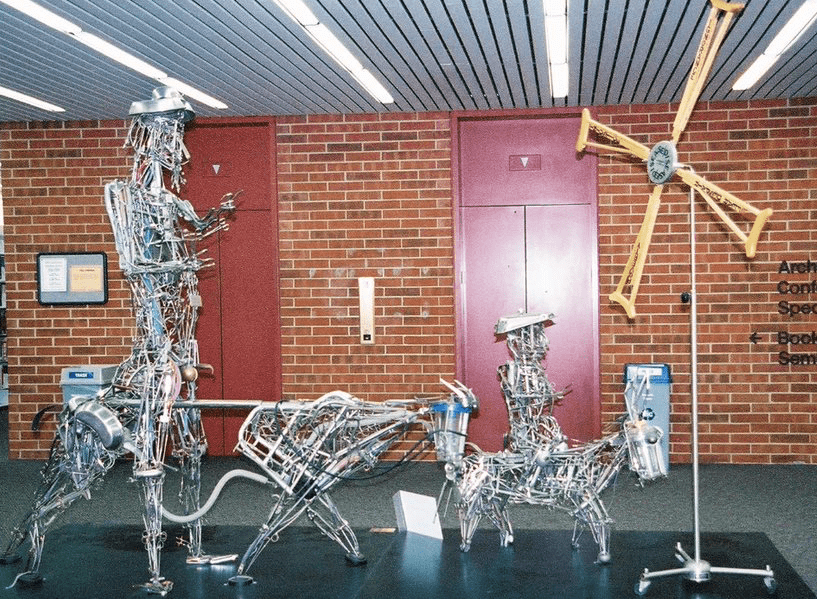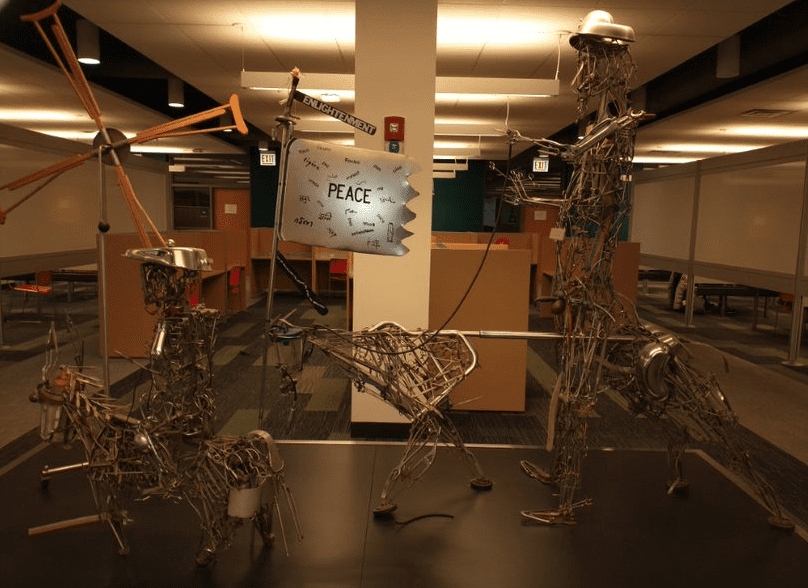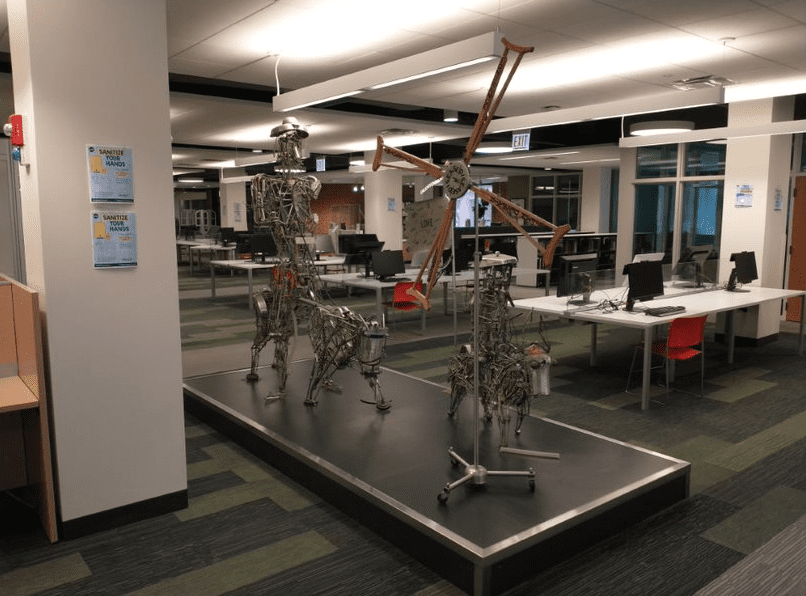Tonse N. K. Raju
Gaithersburg, Maryland, United States
 |
| Figure 1: Don Quixote de la Mancha and Sancho Panza (1982), by Maurice D. Pearlman, MD (1915-1985), University of Illinois, Class of 1938. Donated in his memory by his daughter, Martha Pearlman. Assemblage approximately 7’ X 11’. This picture was taken when the statue was on the third floor of the Library of the Health Sciences, University of Illinois at Chicago. A long rope is placed on Don Quixote’s horse. Four crutches serve to depict the four blades of the “windmill.” On their arms, the inscriptions read: “Poverty,” “Injustice,” “Ignorance and Fear,” and “Despair.” A long rope connecting Don Quixote and his horse, lances, and additional small figures surrounding the statue have been stolen. |
At the entrance hall of the Library of the Health Sciences of the University of Illinois Medical Campus in Chicago, one can see an ensemble of surgical and anesthetic equipment such as knives, forceps, speculum, towel clips, hemostats, kidney trays, IV poles, crutches, x-ray films, anesthetic balloon bags, and more. They are not discarded materials piled up for recycling—instead, they form an assemblage of meticulously conceived, brilliant artwork. Two transparent, bony figures depict famous fictional characters: a fully armored knight-errant on his horse and his squire riding a donkey. Both are carrying lances and are ready to battle “poverty,” “injustice,” “ignorance and fear,” and “despair,” written across the four blades of the “windmill” made of crutches. They are the heroes of the great novel Don Quixote de la Mancha, written by the Spanish writer Miguel de Cervantes (1547-1616).
We see Don Quixote riding his horse Rocinante and Sancho Panza, riding his donkey, Dapple1 (Figures 1 and 2). The top blue banner proclaims “ENLIGHTENMENT” and the middle banner, made of metal that looks white when reflecting light, has an inscription “PEACE” written in twenty-three languages. This banner on the right side (Figure 3) has an inscription that reads “LOVE” in twenty-three languages. The bottom blue banner reads “ONLY HE WHO INTENDS THE ABSURD MAY ATTAIN THE IMPOSSIBLE.”
This stunning and magnificent statue created by Dr. Maurice Pearlman (1915-1985), previously located on the third floor of the library,2 has now been moved to the entrance hall and has been partially restored. It adorns a dark corner of the hallway, hardly drawing the attention of medical students who pass by it.
Dr. Pearlman graduated MD from the University of Illinois Abraham Lincoln School of Medicine in 1939 and served as an ophthalmologist for nearly twenty years before moving to Las Vegas, Nevada. He was not trained in the arts, but admired Cervantes’ great novel and its heroes. He was influenced by the Chicago artist John Kearney and managed to create this artwork using a large collection of discarded surgical instruments he had collected over the years of his practice.2 Pearlman was deeply committed to the humane in the practice of medicine, which is richly displayed in his brilliant creation.
 |
| Figure 2: Side view from the left of the statue, now located on the library’s main floor. A pole with the while banner has an inscription “PEACE” written in 23 languages. The ‘banner’ is actually made of metal, which shines white when light is shown on it. The top blue banner has an inscription “ENLIGHTENMENT” and the bottom blue banner has an inscription, “Only He Who Intends the Absurd may Attain the Impossible.” The Don Quixote figure is holding the rope attached to his horse. |
 |
| Figure 3: Side view from the right of the statue. The banner on its other side has an inscription that reads “LOVE” in 23 languages. |
Deciphering the allegorical meanings of Cervantes’ novel would be beyond the scope of this brief article, but its greatness has been compared to the works of Shakespeare and Dante. In the introduction to the excellent translation by Edith Grossman,1 Harold Bloom says that it is difficult to appreciate the aesthetic truth of Don Quixote and to fully understand the truth of Quixote’s quest because “. . . we confront a reflecting mirror that awes us even while we yield to delight.” He adds, “Fielding and Sterne, Goethe and Thomas Mann, Flaubert and Stendhal, Melville and Mark Twain, Dostoevsky: these are Cervantes’s admirers and pupils.”
But what did Pearlman say about the only artistic creation he produced? While arranging his work for donation to the University of Illinois Library of Health Sciences, he noted, “Behold! . . . Don Quixote de la Mancha, defender of our profession against all assailants or detractors, and knight-errant against life’s cruelties. This sculpture is dedicated to His (and Medicine’s) noble ideals.”2
Nothing more needs to be added.
References
- Cervantes M. Don Quixote: A New Translation by Edith Grossman. New York: HarperCollins Books; 2003.
- Scheinman M. A Guide to Art at the University of Illinois: Urbana-Champaign, Robert Allerton Park and Chicago. Urbana-Champaign, Illinois.: University of Illinois Press; 1995.
Acknowledgment: I thank the Trustees of the University of Illinois for permission to obtain photographs of the stature shown in this picture, and to Mr. Harold Jaffee, Library Assistant for sending Figures 2 and 3.
Image Information
The sculpture: Don Quixote de la Mancha sculpture located on the main floor of the Library of Health Sciences of the University of Illinois in Chicago, Illinois. A plaque at the bottom of the sculpture reads, “This Sculpture by Maurice D. Pearlman, M.D., 1915-1985, University of Illinois College of Medicine, Class of 1938, was donated in his memory by his daughter, Martha Pearlman.” The donation occurred in 1995 to the Trustees of the University of Illinois, who granted a permission to reproduce pictures of this statue for the purposes of this paper in Hektoen International.
Figure 1: The photograph of Don Quixote and de la Mancha statue when it was located on the third floor of the Library of the Health Sciences, University of Illinois in Chicago. Copyright Tonse N.K. Raju, published with permission.
Figure 2: A photograph (side view from the left) of the statute Don Quixote de la Mancha as it appears now on the main floor of the Library of Health Sciences, University of Illinois in Chicago. Photograph by Mr. Harold Jaffe, Library Assistant, Library of the Health Sciences, University of Illinois at Chicago, IL, published with permission.
Figure 3: A photograph (side view from the right) of the statute Don Quixote de la Mancha as it appears now on the main floor of the Library of Health Sciences, University of Illinois in Chicago. Photograph by Mr. Harold Jaffe, Library Assistant, Library of the Health Sciences, University of Illinois at Chicago, IL, published with permission.
TONSE N. K. RAJU, MD (Pediatrics), DCH, FAAP, completed pediatric residency at Cook County Hospital and Neonatal-Perinatal Medicine fellowship at the University of Illinois in Chicago, where he served as Professor of Pediatrics. In 2002, he joined the National Institutes of Health in Bethesda, Maryland, as a Medical Officer where he became the Chief of Pregnancy and Perinatology Branch in 2013. He is currently an Adjunct Professor of Pediatrics at the Uniformed Services University in Bethesda, Maryland, and the Deputy Editor for the Journal of Perinatology, the official journal of the Section on Neonatal Perinatal Medicine of the American Academy of Pediatrics.
Highlighted Vignette Volume 13, Issue 3– Summer 2021
Winter 2021 | Sections | Art Flashes

Leave a Reply